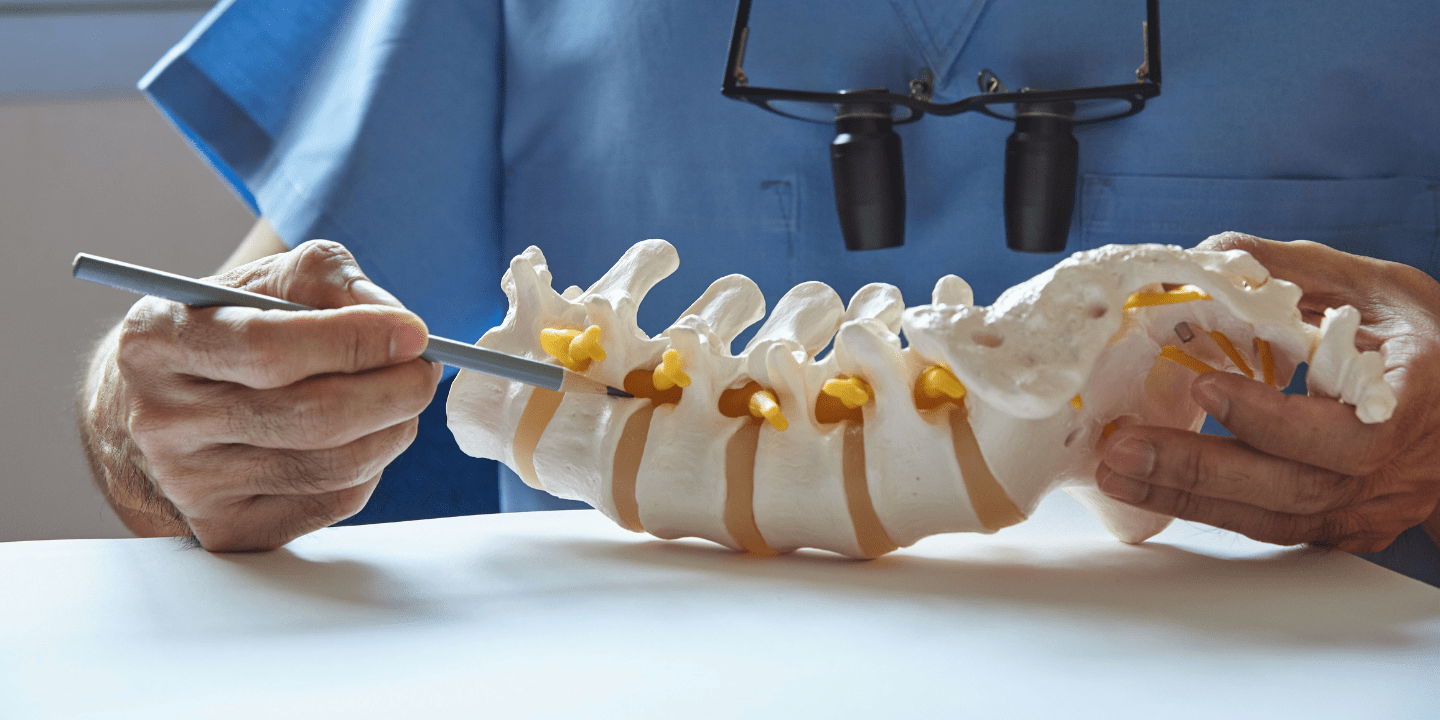Getting to Know the Spine
The spinal column provides the central structure and stability of the human body. The spinal column protects the spinal cord and enables much of our movement and flexibility. It also houses and protects the spinal cord and the nerves that control our limbs. The spinal column is made up of 24 individual vertebrae with small discs between each one as well as the sacrum and the coccyx.
While we think of the spine as being straight, it is actually curves, which helps us stand up correctly.
Explore the Spine
Click the interactive skeleton to the right or navigate the vertical section below to learn more about the different segments of the spine.
Parts of the Spine
Cervical
There are 7 vertebrae in the cervical spine at the top of our spinal column in the neck. The most mobile portion of the spinal column, the cervical vertebrae arch backward creating a “C” curve, allowing us to stand up straight, turn our heads from side to side and look upward. The cervical spine connects the spinal column to the base of the skull and also houses the vertebral arteries which provide the blood flow directly to the back of the brain.
The top two cervical vertebrae, the atlas (the top) and axis (the second), are built differently than the others. The atlas supports the skull on the spine, and the axis allows the atlas to swivel and pivot in different directions. It is between the skull and the spine, and the axis allows the atlas to swivel and pivot around to see in different directions.
The cervical spine supports our heavy heads, but it has smaller muscles than the lumbar spine. Therefore, it is easy to injure the neck in a whiplash-style injure. Poor posture caused by habits such as we looking down at a phone or tablet can also contribute to neck pain. Nerves extend from the cervical spine to the arms. When these nerves are compressed or pinched, they can cause pain, numbness or weakness radiating down the arm, known as cervical radiculopathy.
The top two cervical vertebrae, the atlas (the top) and axis (the second), are built differently than the others. The atlas supports the skull on the spine, and the axis allows the atlas to swivel and pivot in different directions. It is between the skull and the spine, and the axis allows the atlas to swivel and pivot around to see in different directions.
The cervical spine supports our heavy heads, but it has smaller muscles than the lumbar spine. Therefore, it is easy to injure the neck in a whiplash-style injure. Poor posture caused by habits such as we looking down at a phone or tablet can also contribute to neck pain. Nerves extend from the cervical spine to the arms. When these nerves are compressed or pinched, they can cause pain, numbness or weakness radiating down the arm, known as cervical radiculopathy.
Thoracic
The next 12 vertebrae are the thoracic spine. These vertebrae connect to the back of your ribcage and support the important area of the chest and thoracic cavity where your heart and lungs reside.
There is less flexibility in this area, but it does have a natural forward arching curve in the opposite direction of the cervical spine.
Due to the limited movement in this area of the spine, the vertebral discs between the vertebrae are thinner, narrower and less mobile than the others. They are less likely to herniate (slip) or become problematic. Injuries to this area of the spine are more commonly related to bone density and collapse of the vertebrae causing kyphosis and painful compression fractures.
There is less flexibility in this area, but it does have a natural forward arching curve in the opposite direction of the cervical spine.
Due to the limited movement in this area of the spine, the vertebral discs between the vertebrae are thinner, narrower and less mobile than the others. They are less likely to herniate (slip) or become problematic. Injuries to this area of the spine are more commonly related to bone density and collapse of the vertebrae causing kyphosis and painful compression fractures.
Lumbar
The next five vertebrae make up the lumbar spine, or the lower back. Some individuals may be told they have six vertebrae in the lumbar region, but this is usually because the last rib (12th) is not fully developed and therefore resembles a lumbar vertebra.
The lumbar spine, like the cervical spine, has a backward arching “C” curve. The low back is designed to be both flexible and strong, as it supports the majority of the body’s weight, as well as anything you lift or carry.
Lower back pain and injuries are common due to the constant stress placed on the lumbar area from normal activities as well as lifting heavy objects, repetitive twisting and stress to the lower back.
The lumbar spine, like the cervical spine, has a backward arching “C” curve. The low back is designed to be both flexible and strong, as it supports the majority of the body’s weight, as well as anything you lift or carry.
Lower back pain and injuries are common due to the constant stress placed on the lumbar area from normal activities as well as lifting heavy objects, repetitive twisting and stress to the lower back.
Sacrum & Coccyx
The lowest two sections of the spinal column are made up of vertebrae that lack discs and fuse together before birth. The sacrum consists of five vertebrae fused into a triangle-shaped bone. This bone connects to the hips and the back part of the pelvis. The coccyx, or tailbone, consists of the last four vertebrae that fuse into one bone. Many different ligaments and muscles in the pelvis connect to this part of the spine.
Spinal Cord, Nerve Roots & Nerves
Millions of nerve fibers make up the spinal cord, which is responsible for sending information between your brain and the rest of the body. At each level of the spine, certain sections of nerves branch off from a root at the main spinal cord and then branch into many smaller nerves to communicate to an entire part of the body. For example, the nerves for the arms diverge from the cervical area, while the nerves for the legs originate from the lumbar region.
Any possible injury to the spinal cord should be treated as an emergency and should always trigger a call to 911 so the patient can be properly immobilized. In addition to spinal cord injuries, the compression of nerves or nerve roots by herniated discs or arthritic facet joints can cause neurological issues such as pain, numbness and weakness throughout the length of those nerves.
Any possible injury to the spinal cord should be treated as an emergency and should always trigger a call to 911 so the patient can be properly immobilized. In addition to spinal cord injuries, the compression of nerves or nerve roots by herniated discs or arthritic facet joints can cause neurological issues such as pain, numbness and weakness throughout the length of those nerves.
Intervertebral Disc
The discs between the vertebrae consist of an outer fibrous edge and inner gelatinous core that serves as a shock absorber and cushion between the vertebral bodies. The discs allow for a good deal of motion and flexibility in the spine. The disc itself has two portions: a tougher, more fibrous component on the outside, known as the annulus fibrosus, and a softer, more gelatinous center, known as the nucleus pulposus.
Discs initially contain a lot of water, but they lose water content as we age. The discs have no blood supply and do not repair like other bone or muscle. They can become flatter and more worn down over time, lessening the cushioning and motion between the vertebrae. Discs can also bulge out in certain areas, putting pressure on the adjacent nerves and / or the spinal cord tissues.
Disc conditions can occur with age or with acute injury.
Discs initially contain a lot of water, but they lose water content as we age. The discs have no blood supply and do not repair like other bone or muscle. They can become flatter and more worn down over time, lessening the cushioning and motion between the vertebrae. Discs can also bulge out in certain areas, putting pressure on the adjacent nerves and / or the spinal cord tissues.
Disc conditions can occur with age or with acute injury.
Vertebra, Lamina & Foramen
While the vertebrae, or bones that make up the spine, have slightly different shapes in different sections of the back, they share the same basic anatomy.
The vertebra section itself has two parts: the cylindrical section of bone that provides the height and structure, and the bony ring that sticks out of the back. This ring provides a protective space that surrounds the spinal cord. The rings are shaped so they have interlocking segments to provide both structure and mobility.
The lamina is the part of the vertebra that connects to the spinous process, and it is often the site of back surgery. By moving or removing the lamina, surgeons can relieve pressure on the spinal cord and spinal roots. These procedures are known as laminectomies or laminotomies, depending on whether or not the lamina is removed.
The foramen, also known as the intervertebral foramen, is the space created by the interlocking vertebral segments where the nerve roots connect the spinal cord to the rest of the body. If this space becomes too small due to degenerative disease or other conditions, it can cause spinal stenosis and pressure on area nerves. A foraminotomy is a common surgical procedure in which this open area is surgically enlarged to decompress nerves.
The vertebra section itself has two parts: the cylindrical section of bone that provides the height and structure, and the bony ring that sticks out of the back. This ring provides a protective space that surrounds the spinal cord. The rings are shaped so they have interlocking segments to provide both structure and mobility.
The lamina is the part of the vertebra that connects to the spinous process, and it is often the site of back surgery. By moving or removing the lamina, surgeons can relieve pressure on the spinal cord and spinal roots. These procedures are known as laminectomies or laminotomies, depending on whether or not the lamina is removed.
The foramen, also known as the intervertebral foramen, is the space created by the interlocking vertebral segments where the nerve roots connect the spinal cord to the rest of the body. If this space becomes too small due to degenerative disease or other conditions, it can cause spinal stenosis and pressure on area nerves. A foraminotomy is a common surgical procedure in which this open area is surgically enlarged to decompress nerves.
Facets, Facet Joints, Spinous Process
The facets are the paired joints in the back of the spinal column. The facets connect to the vertebra above and below like a chain. The places where these pieces connect are the facet joints, and they allow the segments of the spine to interlock, providing structure while allowing mobility and flexibility. Problems with the facet joints can develop from age-related degeneration, poor posture or body mechanics, repetitive stress or injury and acute injury or trauma.
The spinous process protrudes from the back of each vertebra. It is an important anchor for the ligaments and muscles that support the back.
The spinous process protrudes from the back of each vertebra. It is an important anchor for the ligaments and muscles that support the back.
There are 7 vertebrae in the cervical spine at the top of our spinal column in the neck. The most mobile portion of the spinal column, the cervical vertebrae arch backward creating a “C” curve, allowing us to stand up straight, turn our heads from side to side and look upward. The cervical spine connects the spinal column to the base of the skull and also houses the vertebral arteries which provide the blood flow directly to the back of the brain.
The top two cervical vertebrae, the atlas (the top) and axis (the second), are built differently than the others. The atlas supports the skull on the spine, and the axis allows the atlas to swivel and pivot in different directions. It is between the skull and the spine, and the axis allows the atlas to swivel and pivot around to see in different directions.
The cervical spine supports our heavy heads, but it has smaller muscles than the lumbar spine. Therefore, it is easy to injure the neck in a whiplash-style injure. Poor posture caused by habits such as we looking down at a phone or tablet can also contribute to neck pain. Nerves extend from the cervical spine to the arms. When these nerves are compressed or pinched, they can cause pain, numbness or weakness radiating down the arm, known as cervical radiculopathy.
The top two cervical vertebrae, the atlas (the top) and axis (the second), are built differently than the others. The atlas supports the skull on the spine, and the axis allows the atlas to swivel and pivot in different directions. It is between the skull and the spine, and the axis allows the atlas to swivel and pivot around to see in different directions.
The cervical spine supports our heavy heads, but it has smaller muscles than the lumbar spine. Therefore, it is easy to injure the neck in a whiplash-style injure. Poor posture caused by habits such as we looking down at a phone or tablet can also contribute to neck pain. Nerves extend from the cervical spine to the arms. When these nerves are compressed or pinched, they can cause pain, numbness or weakness radiating down the arm, known as cervical radiculopathy.
The next 12 vertebrae are the thoracic spine. These vertebrae connect to the back of your ribcage and support the important area of the chest and thoracic cavity where your heart and lungs reside.
There is less flexibility in this area, but it does have a natural forward arching curve in the opposite direction of the cervical spine.
Due to the limited movement in this area of the spine, the vertebral discs between the vertebrae are thinner, narrower and less mobile than the others. They are less likely to herniate (slip) or become problematic. Injuries to this area of the spine are more commonly related to bone density and collapse of the vertebrae causing kyphosis and painful compression fractures.
There is less flexibility in this area, but it does have a natural forward arching curve in the opposite direction of the cervical spine.
Due to the limited movement in this area of the spine, the vertebral discs between the vertebrae are thinner, narrower and less mobile than the others. They are less likely to herniate (slip) or become problematic. Injuries to this area of the spine are more commonly related to bone density and collapse of the vertebrae causing kyphosis and painful compression fractures.
The next five vertebrae make up the lumbar spine, or the lower back. Some individuals may be told they have six vertebrae in the lumbar region, but this is usually because the last rib (12th) is not fully developed and therefore resembles a lumbar vertebra.
The lumbar spine, like the cervical spine, has a backward arching “C” curve. The low back is designed to be both flexible and strong, as it supports the majority of the body’s weight, as well as anything you lift or carry.
Lower back pain and injuries are common due to the constant stress placed on the lumbar area from normal activities as well as lifting heavy objects, repetitive twisting and stress to the lower back.
The lumbar spine, like the cervical spine, has a backward arching “C” curve. The low back is designed to be both flexible and strong, as it supports the majority of the body’s weight, as well as anything you lift or carry.
Lower back pain and injuries are common due to the constant stress placed on the lumbar area from normal activities as well as lifting heavy objects, repetitive twisting and stress to the lower back.
The lowest two sections of the spinal column are made up of vertebrae that lack discs and fuse together before birth. The sacrum consists of five vertebrae fused into a triangle-shaped bone. This bone connects to the hips and the back part of the pelvis. The coccyx, or tailbone, consists of the last four vertebrae that fuse into one bone. Many different ligaments and muscles in the pelvis connect to this part of the spine.
Millions of nerve fibers make up the spinal cord, which is responsible for sending information between your brain and the rest of the body. At each level of the spine, certain sections of nerves branch off from a root at the main spinal cord and then branch into many smaller nerves to communicate to an entire part of the body. For example, the nerves for the arms diverge from the cervical area, while the nerves for the legs originate from the lumbar region.
Any possible injury to the spinal cord should be treated as an emergency and should always trigger a call to 911 so the patient can be properly immobilized. In addition to spinal cord injuries, the compression of nerves or nerve roots by herniated discs or arthritic facet joints can cause neurological issues such as pain, numbness and weakness throughout the length of those nerves.
Any possible injury to the spinal cord should be treated as an emergency and should always trigger a call to 911 so the patient can be properly immobilized. In addition to spinal cord injuries, the compression of nerves or nerve roots by herniated discs or arthritic facet joints can cause neurological issues such as pain, numbness and weakness throughout the length of those nerves.
The discs between the vertebrae consist of an outer fibrous edge and inner gelatinous core that serves as a shock absorber and cushion between the vertebral bodies. The discs allow for a good deal of motion and flexibility in the spine. The disc itself has two portions: a tougher, more fibrous component on the outside, known as the annulus fibrosus, and a softer, more gelatinous center, known as the nucleus pulposus.
Discs initially contain a lot of water, but they lose water content as we age. The discs have no blood supply and do not repair like other bone or muscle. They can become flatter and more worn down over time, lessening the cushioning and motion between the vertebrae. Discs can also bulge out in certain areas, putting pressure on the adjacent nerves and / or the spinal cord tissues.
Disc conditions can occur with age or with acute injury.
Discs initially contain a lot of water, but they lose water content as we age. The discs have no blood supply and do not repair like other bone or muscle. They can become flatter and more worn down over time, lessening the cushioning and motion between the vertebrae. Discs can also bulge out in certain areas, putting pressure on the adjacent nerves and / or the spinal cord tissues.
Disc conditions can occur with age or with acute injury.
While the vertebrae, or bones that make up the spine, have slightly different shapes in different sections of the back, they share the same basic anatomy.
The vertebra section itself has two parts: the cylindrical section of bone that provides the height and structure, and the bony ring that sticks out of the back. This ring provides a protective space that surrounds the spinal cord. The rings are shaped so they have interlocking segments to provide both structure and mobility.
The lamina is the part of the vertebra that connects to the spinous process, and it is often the site of back surgery. By moving or removing the lamina, surgeons can relieve pressure on the spinal cord and spinal roots. These procedures are known as laminectomies or laminotomies, depending on whether or not the lamina is removed.
The foramen, also known as the intervertebral foramen, is the space created by the interlocking vertebral segments where the nerve roots connect the spinal cord to the rest of the body. If this space becomes too small due to degenerative disease or other conditions, it can cause spinal stenosis and pressure on area nerves. A foraminotomy is a common surgical procedure in which this open area is surgically enlarged to decompress nerves.
The vertebra section itself has two parts: the cylindrical section of bone that provides the height and structure, and the bony ring that sticks out of the back. This ring provides a protective space that surrounds the spinal cord. The rings are shaped so they have interlocking segments to provide both structure and mobility.
The lamina is the part of the vertebra that connects to the spinous process, and it is often the site of back surgery. By moving or removing the lamina, surgeons can relieve pressure on the spinal cord and spinal roots. These procedures are known as laminectomies or laminotomies, depending on whether or not the lamina is removed.
The foramen, also known as the intervertebral foramen, is the space created by the interlocking vertebral segments where the nerve roots connect the spinal cord to the rest of the body. If this space becomes too small due to degenerative disease or other conditions, it can cause spinal stenosis and pressure on area nerves. A foraminotomy is a common surgical procedure in which this open area is surgically enlarged to decompress nerves.
The facets are the paired joints in the back of the spinal column. The facets connect to the vertebra above and below like a chain. The places where these pieces connect are the facet joints, and they allow the segments of the spine to interlock, providing structure while allowing mobility and flexibility. Problems with the facet joints can develop from age-related degeneration, poor posture or body mechanics, repetitive stress or injury and acute injury or trauma.
The spinous process protrudes from the back of each vertebra. It is an important anchor for the ligaments and muscles that support the back.
The spinous process protrudes from the back of each vertebra. It is an important anchor for the ligaments and muscles that support the back.






